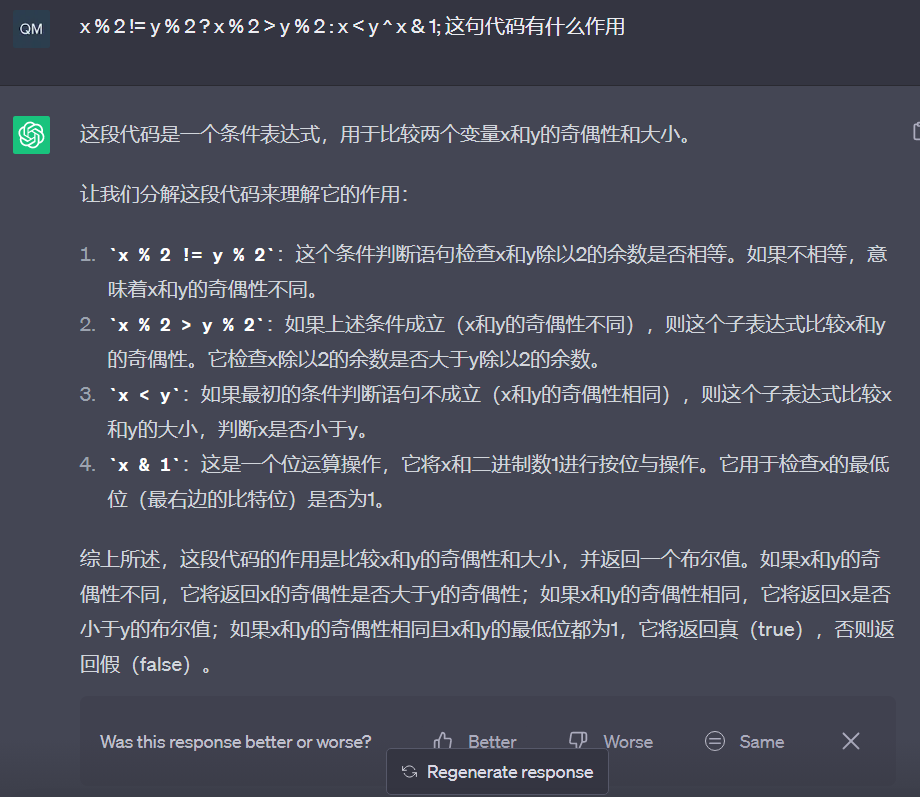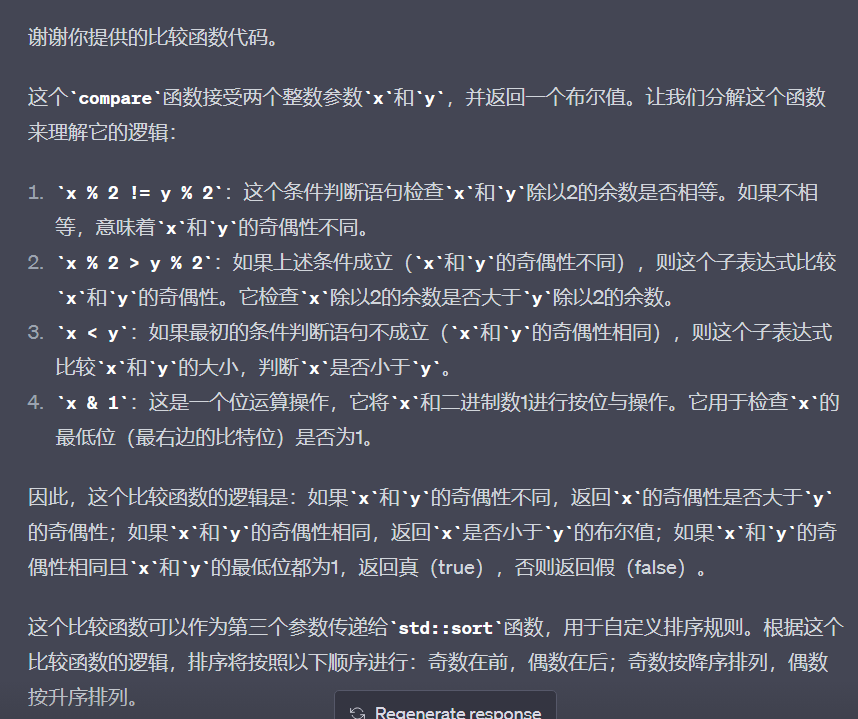机试day3
排序
描述
对输入的n个数进行排序并输出。
输入描述:
输入的第一行包括一个整数n(1<=n<=100)。 接下来的一行包括n个整数。
输出描述:
可能有多组测试数据,对于每组数据,将排序后的n个整数输出,每个数后面都有一个空格。 每组测试数据的结果占一行。
输入:
4
1 4 3 2
输出:
1 2 3 4 思路:直接引用algorithm库中的sort函数排序即可,后续学习数据机构中的排序算法
#include <iostream>
#include <algorithm>
using namespace std;
int main() {
int n;
while (scanf("%d", &n)!=EOF) {
int arr[n];
for (int i = 0; i < n; i++) {
scanf("%d", arr + i);
}
sort(arr, arr + n);
for (int i = 0; i < n; i++) {
printf("%d ", arr[i]);
}
}
}成绩排序
描述
用一维数组存储学号和成绩,然后,按成绩排序输出。
输入描述:
输入第一行包括一个整数N(1<=N<=100),代表学生的个数。 接下来的N行每行包括两个整数p和q,分别代表每个学生的学号和成绩。
输出描述:
按照学生的成绩从小到大进行排序,并将排序后的学生信息打印出来。 如果学生的成绩相同,则按照学号的大小进行从小到大排序。
思路:使用sort的自定义比较,返回结果为true则x在前,y在后;同时为了更好表示学生这个结构体,使用了struct来预定义
#include <iostream>
#include <algorithm>
using namespace std;
struct Student{
int number, score;
};
bool compare(Student x, Student y){
if (x.score == y.score) {
return x.number < y.number;
} else {
return x.score < y.score;
}
}
int main() {
int n;
while (scanf("%d", &n)!=EOF) {
Student s[n];
for (int i = 0; i < n; i++) {
scanf("%d %d", &s[i].number, &s[i].score);
}
sort(s, s + n, compare);
for (int i = 0; i < n; i++) {
printf("%d %d\n", s[i].number, s[i].score);
}
}
}成绩排序
描述
查找和排序
题目:输入任意(用户,成绩)序列,可以获得成绩从高到低或从低到高的排列,相同成绩
都按先录入排列在前的规则处理。
示例:
jack 70
peter 96
Tom 70
smith 67
从高到低 成绩
peter 96
jack 70
Tom 70
smith 67
从低到高
smith 67
jack 70
Tom 70
peter 96
输入描述:
注意一个case里面有多组样例,请用循环处理输入 输入多行,先输入要排序的人的个数,然后输入排序方法0(降序)或者1(升序)再分别输入他们的名字和成绩,以一个空格隔开。
输出描述:
按照指定方式输出名字和成绩,名字和成绩之间以一个空格隔开
思路:本题在前两题的基础上增加了选择是否升序或降序,因此分别写俩函数即可,另外增加了string类型,输入输出最好用c++的方式,即cin、cout
#include <iostream>
#include <algorithm>
using namespace std;
struct Student{
string name;
int score, order;
};
bool CompareDescending(Student x, Student y){
if (x.score == y.score) {
return x.order < y.order;
} else {
return x.score > y.score;
}
}
bool CompareAscending(Student x, Student y){
if (x.score == y.score) {
return x.order < y.order;
} else {
return x.score < y.score;
}
}
int main() {
int n, compare;
while(scanf("%d", &n)!=EOF) {
Student s[n];
scanf("%d", &compare);
for (int i = 0; i < n; i++) {
cin >> s[i].name >> s[i].score;
s[i].order = i;
}
if (compare) {
sort(s, s + n, CompareAscending);
} else {
sort(s, s + n, CompareDescending);
}
for (int i = 0; i < n; i++) {
cout << s[i].name << " " << s[i].score << endl;
}
}
}特殊排序
描述
输入一系列整数,将其中最大的数挑出(如果有多个,则挑出一个即可),并将剩下的数进行排序,如果无剩余的数,则输出-1。
输入描述:
输入第一行包括1个整数N,1<=N<=1000,代表输入数据的个数。 接下来的一行有N个整数。
输出描述:
可能有多组测试数据,对于每组数据, 第一行输出一个整数,代表N个整数中的最大值,并将此值从数组中去除,将剩下的数进行排序。 第二行将排序的结果输出。
思路:没啥特殊的,无非是排好后的数组,最后一个输出在第一行,剩下的输出在下一行;如果没有剩下的输出-1即可
#include <iostream>
#include <algorithm>
using namespace std;
int main() {
int n;
while (scanf("%d", &n) != EOF) {
int arr[n];
for (int i = 0; i < n; i++) {
scanf("%d", arr + i);
}
sort(arr, arr + n);
printf("%d\n", arr[n-1]);
if (n - 1) {
for (int i = 0; i < n-1; i++) {
printf("%d ", arr[i]);
}
} else {
printf("-1");
}
}
}整数奇偶排序
整数奇偶排序_牛客题霸_牛客网 (nowcoder.com)
描述
输入10个整数,彼此以空格分隔。重新排序以后输出(也按空格分隔),要求: 1.先输出其中的奇数,并按从大到小排列; 2.然后输出其中的偶数,并按从小到大排列。
输入描述:
任意排序的10个整数(0~100),彼此以空格分隔。
输出描述:
可能有多组测试数据,对于每组数据,按照要求排序后输出,由空格分隔。 1. 测试数据可能有很多组,请使用while(cin>>a[0]>>a[1]>>...>>a[9])类似的做法来实现; 2. 输入数据随机,有可能相等。
法1:分别接收奇数和偶数
思路:分别定义了偶数和奇数数组接收,分别排序,看起来有些麻烦
#include <cstdio>
#include <iostream>
#include <algorithm>
using namespace std;
bool CompareDescending(int x, int y){
return x > y;
}
int main() {
int odd[10], even[10], a[10];
while (cin>>a[0]>>a[1]>>a[2]>>a[3]>>a[4]>>a[5]>>a[6]>>a[7]>>a[8]>>a[9]) {
int odd_n = 0, even_n = 0;
for (int i = 0; i < 10; i++) {
if (a[i] % 2) {
odd[odd_n++] = a[i];
} else {
even[even_n++] = a[i];
}
}
sort(odd, odd + odd_n, CompareDescending);
sort(even, even + even_n);
for (int i = 0; i < odd_n; i++) {
printf("%d ", odd[i]);
}
for (int i = 0; i < even_n; i++) {
printf("%d ", even[i]);
}
}
}法2:自定义一个全新且十分巧妙的sort函数
该函数如下,短短的一行,十分震撼!
bool compare(int x, int y){
return x % 2 != y % 2 ? x % 2 > y % 2 : x < y ^ x & 1;
}原理解析下:这是一个三目运算,最开始的条件判断的是是否同奇数或同偶数,如果不是奇数的排前面,偶数的排后面。接着如果都是奇数或偶数,使用y ^ x & 1来判断大小,这句话涉及了运算符的优先级!
| 优先级 | 运算符 | ||
|---|---|---|---|
| 1 | [] () . -> | ||
| 2 | -(负号运算符) ~(取反符号) ++ -- *(取值运算符) &(取地址运算符) !(逻辑非) sizeof | ||
| 3 | / *(除号) % | ||
| 4 | + -(减号) | ||
| 5 | << >> | ||
| 6 | > >= < <= | ||
| 7 | == != | ||
| 8 | &(按位与) | ||
| 9 | ^(按位异或) | ||
| 10 | \ | (按位或) | |
| 11 | && | ||
| 12 | \ | \ | |
| 13 | ?:(条件运算符) | ||
| 14 | = += -= /= *= %= <<= >>= &=\ | = ^=(各种先计算后赋值) | |
| 15 | , |
所以计算先后顺序是:
- 比较x、y大小,得到0或1
- 按位异或,将0或1和x异或,如果x是偶数,0和x异或得到偶数,1和x异或得到奇数;如果x是奇数,0和x异或得到奇数,1和x异或得到偶数
- 按位与,偶数和1与得到0,奇数和1与得到1
假设都是奇数,x<y,则为1,1和x异或得到偶数,偶数和1与得到0,因此同为奇数小的放后面,即降序
假设都是偶数,x<y,则为1,1和x异或得到奇数,奇数和1与得到1,因此同为偶数小的放前面,即升序
来看下ChatGPT咋解释[doge],可以看到直接问这句代码啥意思,他不清楚

但是你把整个比较函数给出来,并说明这是c++的sort函数中的第三个参数,他答案完全正确,就是分析比较浅层!

ChatGPT 赞!
法3:比法2简单点,不要这么复杂的三目了
思路:四种情况都去做个判断!
#include <cstdio>
#include <iostream>
#include <algorithm>
using namespace std;
bool compare(int x, int y){
if (x % 2 == 1 && y % 2 == 1) {
return x > y;
}
else if (x % 2 == 0 && y % 2 == 0) {
return x < y;
}
else if (x % 2 == 1 && y % 2 == 0) {
return true; // 奇数放前面
}
else {
return false; // 偶数放后面
}
}
int main() {
int a[10];
while (cin>>a[0]>>a[1]>>a[2]>>a[3]>>a[4]>>a[5]>>a[6]>>a[7]>>a[8]>>a[9]) {
sort(a, a + 10, compare);
for (int i = 0; i < 10; i++) {
printf("%d ", a[i]);
}
}
}小白鼠排队
描述
N只小白鼠(1 <= N <= 100),每只鼠头上戴着一顶有颜色的帽子。现在称出每只白鼠的重量,要求按照白鼠重量从大到小的顺序输出它们头上帽子的颜色。帽子的颜色用“red”,“blue”等字符串来表示。不同的小白鼠可以戴相同颜色的帽子。白鼠的重量用整数表示。
输入描述:
多案例输入,每个案例的输入第一行为一个整数N,表示小白鼠的数目。 下面有N行,每行是一只白鼠的信息。第一个为不大于100的正整数,表示白鼠的重量,;第二个为字符串,表示白鼠的帽子颜色,字符串长度不超过10个字符。 注意:白鼠的重量各不相同。
输出描述:
每个案例按照白鼠的重量从大到小的顺序输出白鼠的帽子颜色。
思路:前面做过了此题便简单至极
#include <iostream>
#include <algorithm>
using namespace std;
struct Mouse {
int weight;
string color;
};
bool compare(Mouse x, Mouse y) {
return x.weight > y.weight;
}
int main() {
int N;
while (scanf("%d", &N) != EOF) {
Mouse m[N];
for (int i = 0; i < N; i++) {
cin >> m[i].weight >> m[i].color;
}
sort(m, m + N, compare);
for (int i = 0; i < N; i++) {
cout << m[i].color << endl;
}
}
}奥运排序问题
描述
按要求,给国家进行排名。
输入描述:
有多组数据。 第一行给出国家数N,要求排名的国家数M,国家号从0到N-1。 第二行开始的N行给定国家或地区的奥运金牌数,奖牌数,人口数(百万)。 接下来一行给出M个国家号。
输出描述:
排序有4种方式: 金牌总数 奖牌总数 金牌人口比例 奖牌人口比例 对每个国家给出最佳排名排名方式 和 最终排名 格式为: 排名:排名方式 如果有相同的最终排名,则输出排名方式最小的那种排名,对于排名方式,金牌总数 < 奖牌总数 < 金牌人口比例 < 奖牌人口比例 如果有并列排名的情况,即如果出现金牌总数为 100,90,90,80.则排名为1,2,2,4. 每组数据后加一个空行。
输入:
4 4
4 8 1
6 6 2
4 8 2
2 12 4
0 1 2 3
4 2
8 10 1
8 11 2
8 12 3
8 13 4
0 3
输出:
1:3
1:1
2:1
1:2
1:1
1:1法1:暴力遍历,没用到排序
思路:最开始想用排序来着,但没思路怎么设计结构比较多种排序方式;因此瞅了眼评论区,看到一个思路是遍历所有国家,排名比自己好的给自己的排名+1;思路很好,具体案例一堆bug【如下,提交了20次,最后两次才对:cry:】

关键点:
- 注意比例可能有小数,因此不可以使用int型了(最开始测试案例对了,但提交却一堆通不过)
- 先遍历需要找最好排名及排名方式的国家,再遍历四种排序方式;具体而言就是把四种值存储到二维字典中,一行行比较,选取最小排名及其排名方式
- 注意!!!可能会有金牌数或总奖牌数为0的情况,甚至有人口为0!?这咋除,我当时花了好长时间排查这个除以0的bug,甚至动用了math库里判断inf或nan的函数,但始终有那么一组案例中的一个不对。事实证明不是根据人口数为0设置比例为0,而是前两个奖牌数为0时设置比例为0,原因搞不懂,感觉题目有些bug
#include <iostream>
#include <algorithm>
using namespace std;
int main() {
int N, M;
while (scanf("%d%d", &N, &M) != EOF) {
float c[N][4];
for (int i = 0; i < N; i++) {
scanf("%f%f%f", &c[i][0], &c[i][1], &c[i][2]);
c[i][3] = c[i][1] ? c[i][1] * 1.0 / c[i][2] : 0;
c[i][2] = c[i][0] ? c[i][0] * 1.0 / c[i][2] : 0;
// printf("%f %f %f %f\n", c[i][0], c[i][1], c[i][2], c[i][3]);
}
int country_order[M];
for (int j = 0; j < M; j++) {
scanf("%d", &country_order[j]);
}
for (int k = 0; k < M; k++) {
int best_rank = N, best_sort = 1;
for (int j = 0; j < 4; j++) {
int rank = 1;
for (int i = 0; i < N; i++) {
if (c[i][j] > c[country_order[k]][j]) {
rank += 1;
}
}
if (rank < best_rank) {
best_rank = rank;
best_sort = j + 1;
}
}
printf("%d:%d\n", best_rank, best_sort);
}
printf("\n");
}
}法2:排序算法思路
下一次看
